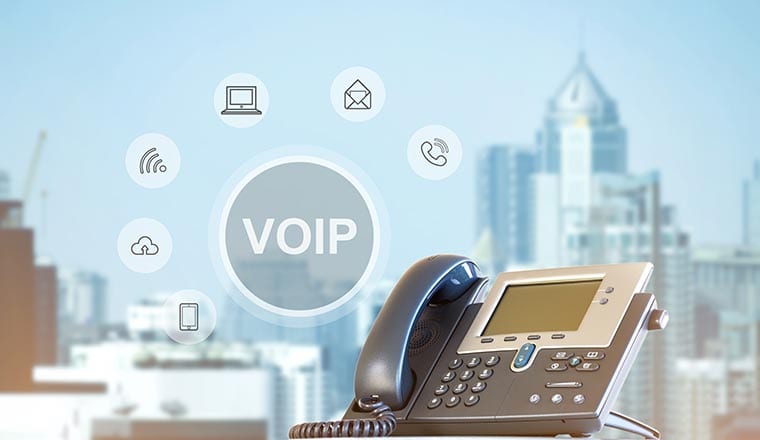
What are VoIP Phone Systems and How Do They Work?
In the realm of business communications, efficiency and reliability are paramount. As traditional phone systems gradually give way to more advanced technologies, Voice over Internet Protocol (VoIP) systems are gaining prominence. This blog delves deep into the mechanics of VoIP phone systems, explains how they function, and compares them to other business phone system options.
Understanding VoIP Phone Systems
Voice over Internet Protocol (VoIP) phone systems represent a significant advancement in communication technology, reshaping how businesses interact both internally and with the outside world. The rise of VoIP is closely linked to the digital transformation that businesses across all sectors are experiencing, providing a more flexible and cost-effective solution than traditional telephony. To truly appreciate the benefits of VoIP, it is crucial to delve into how these systems operate and the underlying technology that powers them.
Advantages of VoIP Systems
Voice over Internet Protocol (VoIP) systems offer a range of benefits that make them a superior choice for many businesses compared to traditional phone systems. This transition to VoIP can be attributed to its inherent efficiencies and advanced features that traditional systems simply cannot match.
Cost-Effectiveness
One of the most compelling advantages of VoIP is its cost-effectiveness. VoIP systems use the internet to make calls, which significantly reduces the costs associated with traditional phone lines. For businesses, this means lower monthly bills, especially when it comes to long-distance and international calls. Additionally, because VoIP requires less physical infrastructure than traditional phone systems, the initial setup and ongoing maintenance costs are also reduced. This can be particularly beneficial for small businesses or startups that need to manage their expenses carefully.
Scalability
VoIP systems are highly scalable, which makes them ideal for growing businesses. Adding new lines or extensions can often be done with minimal effort and without significant costs. In contrast, traditional phone systems typically require physical installations and hardware for each new line, which can be costly and time-consuming. VoIP’s scalability ensures that businesses can easily adjust their communication systems as they expand, without undergoing major infrastructural changes.
Flexibility and Mobility
With VoIP, employees can make and receive calls from anywhere, not just from phones connected to physical lines in the office. This is because VoIP systems can be accessed via any internet-connected device, such as smartphones, laptops, or tablets. This flexibility is invaluable for businesses with remote teams, frequent travelers, or those who employ telecommuting practices. It ensures that employees remain connected and productive regardless of their location.

Advanced Features
VoIP systems come packed with a suite of advanced features that are often available without additional charges. These include video conferencing, voicemail to email transcription, call forwarding, and auto-attendant features. Such capabilities can enhance business communications significantly, making processes more efficient. For example, the auto-attendant feature can direct callers to the appropriate department without human intervention, while voicemail to email ensures messages are never missed and can be accessed easily from anywhere.
Enhanced Communication Quality
Modern VoIP technology offers superior sound quality compared to traditional phone systems, provided there is a reliable internet connection. This clarity makes communication more precise and effective. Improved sound quality is particularly important in professional settings where every word counts, and miscommunication can lead to significant misunderstandings.
Integration with Other Business Systems
VoIP technology integrates seamlessly with many business applications, enhancing productivity and efficiency. For instance, VoIP systems can be connected to customer relationship management (CRM) software, allowing for better customer service and easier access to client information during calls. This integration can automate and streamline various processes, which helps businesses operate more smoothly and reduces the chances of errors.
VoIP systems offer a compelling array of advantages over traditional phone systems, making them a preferred choice for modern businesses. The transition to VoIP can significantly reduce costs, increase scalability, enhance flexibility, and provide a wealth of useful features that improve communication efficiency. As businesses continue to evolve and look for innovative ways to improve operations, VoIP stands out as a key technology that can support their growth in an increasingly connected world.

Comparing Other Business Phone System Options
While VoIP stands out for many businesses, some may find alternative or complementary phone systems more aligned with their specific needs.
Public Switched Telephone Network (PSTN)
Traditional landline telephony, known as PSTN, uses copper wires to transmit analog voice communications. It is highly reliable and familiar but often comes with higher costs, especially for extensive infrastructure and long-distance communications.
Private Branch Exchange (PBX) Systems
PBX systems serve as private telephone networks within a company. Traditional PBX setups require significant hardware and are maintained on-site, but modern IP-PBX systems blend PBX functionalities with VoIP's digital advantages, offering a hybrid solution that supports both standard telephone lines and internet voice data.
Hybrid Phone Systems
For businesses transitioning from traditional to modern systems, hybrid phone systems offer a middle ground. These systems integrate the reliability of PSTN with the flexibility and feature-rich framework of VoIP. This setup is ideal for businesses looking for a phased approach to upgrading their communication infrastructure.
Cost-Effectiveness of VoIP Systems
Understanding the cost-effectiveness of VoIP systems requires a detailed look at the average expenses associated with implementing and maintaining these systems. VoIP can offer significant cost savings compared to traditional phone systems, but the actual costs can vary based on several factors including the size of your business, the features you require, and your usage patterns.

Initial Setup and Monthly Fees
The initial setup cost for a VoIP system can be quite low, especially if the business already has existing internet infrastructure and compatible devices. Some VoIP providers offer free initial setup, while others may charge a fee depending on the complexity of the setup required. This fee usually covers the configuration of the system to fit specific business needs, including the integration with other software if necessary.
The ongoing costs of a VoIP system are predominantly made up of monthly fees. These fees can vary widely:
- Basic VoIP services for small businesses can start as low as $10 to $20 per user per month. These basic plans typically include features like call forwarding, voicemail, caller ID, and sometimes unlimited calling within the country.
- Mid-range plans might cost between $20 to $40 per user per month and include additional features such as conferencing, text messaging, and higher tiers of customer support.
- Premium packages can range from $40 to $60 per user per month and are inclusive of advanced functionalities like integration capabilities with CRM systems, advanced call management, and analytics features.
Additional Costs
While monthly fees cover the majority of expenses associated with VoIP systems, there are potential additional costs that businesses should consider:
- Hardware: If you require specific VoIP phones or headsets, this can be an added expense. Some businesses choose to use their existing hardware (like computers and smartphones) to access their VoIP systems, which can mitigate these costs.
- Bandwidth: VoIP services require a robust internet connection. If your current bandwidth is insufficient, you may need to upgrade your internet service, which could increase your monthly internet costs.
- International Calls: While many VoIP providers offer competitive rates for international calling, these calls are typically not included in unlimited calling plans. Businesses making frequent international calls should factor this into their cost assessments.
- Add-On Features: Certain specialized features like additional numbers, virtual fax services, or premium integrations with third-party services might incur additional fees.

Comparing Costs with Traditional Phone Systems
Traditional landline systems often involve higher setup costs, especially when establishing a new physical line network. Monthly fees for traditional phone services can vary significantly based on usage, long-distance charges, and the cost of additional features which are often standard with VoIP plans.
Additionally, traditional systems don't typically offer the same level of flexibility or scalability without significant cost increases. For example, adding a new line to a traditional phone system often requires physical wiring and a more complex setup, which can be costly.
Selecting the right phone system hinges on various factors, including operational costs, communication needs, scalability, and the anticipated trajectory of business growth. VoIP provides a versatile and efficient platform that meets the diverse requirements of contemporary businesses by combining cost-effectiveness with a robust suite of communicative functions. Whether the goal is to reduce expenditures, augment communication capabilities, or future-proof operations, VoIP presents a compelling choice for today’s dynamic business environments.
Author: Hudson Piccini
Hudson Cynar, a Harvard University alumna and the owner of three prosperous enterprises, is a distinguished business consultant, author, and writer. Her expertise spans multiple business sectors, with a particular emphasis on storage containers, commercial copiers, payroll services, and medical billing software. Dedicatedly investing thousands of hours into product and service research, Hudson crafts insightful reviews to guide entrepreneurs in making informed decisions for their businesses.
